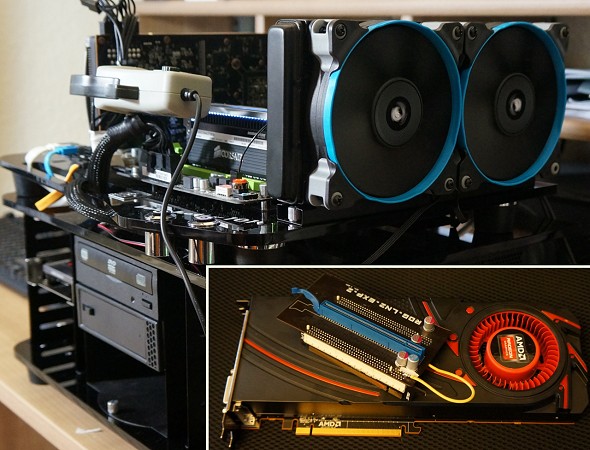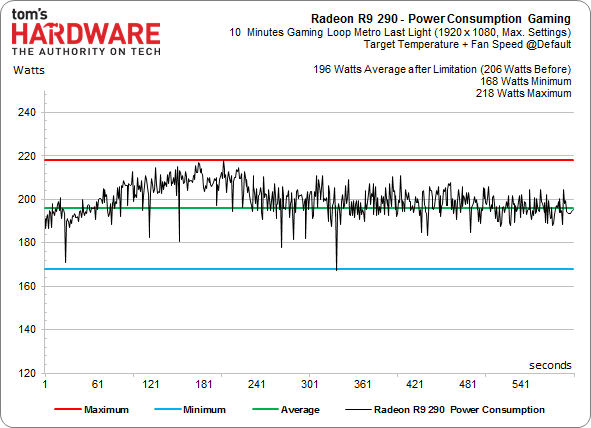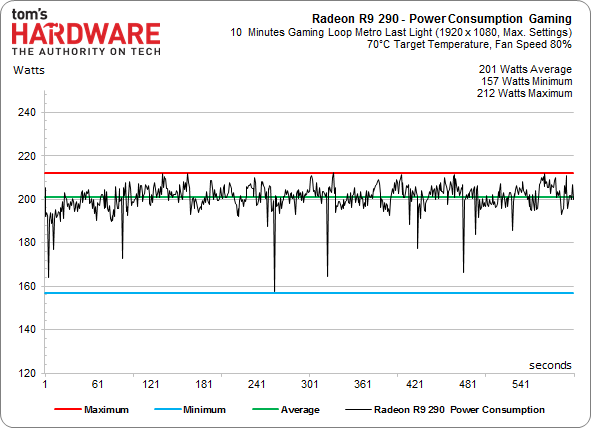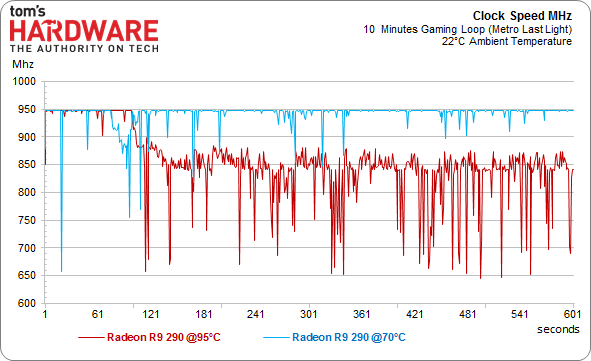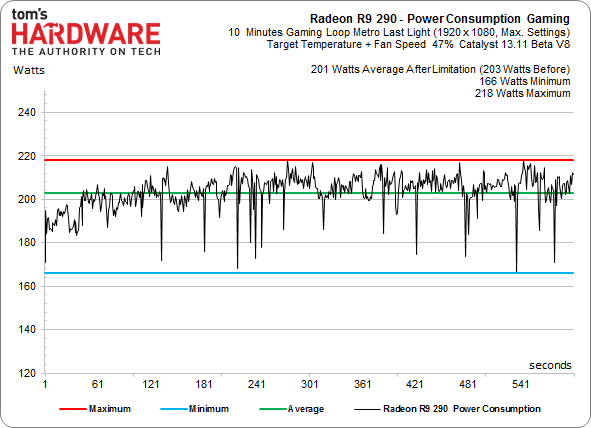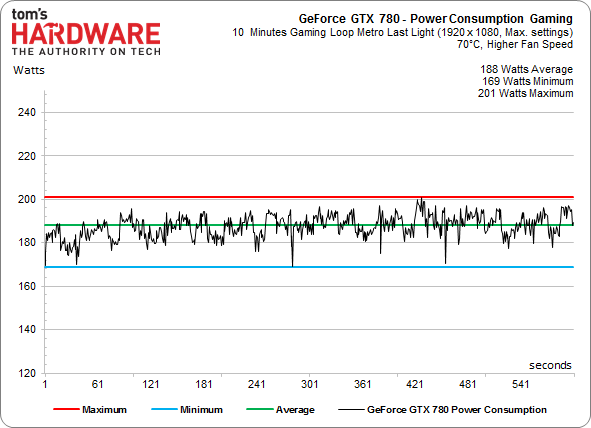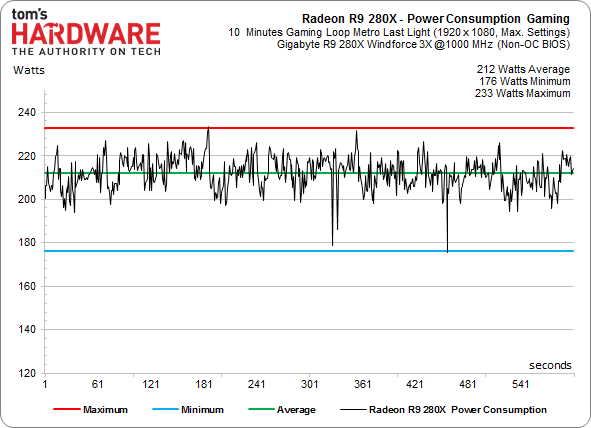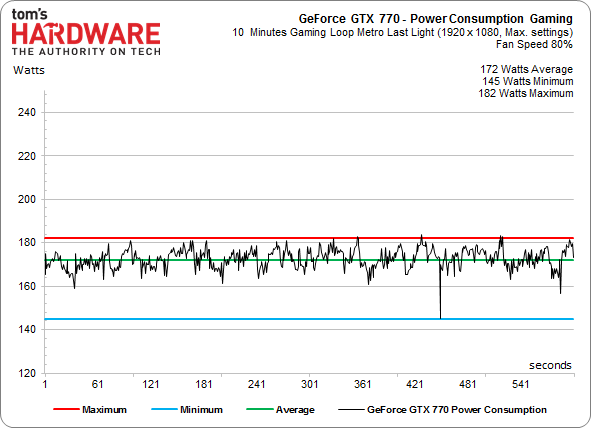AMD Radeon R9 290 Review: Fast And $400, But Is It Consistent?
We have all the makings of a dramatic launch: new high-end hardware, a last-minute delay for more performance, a crazy twist based on retail hardware, and our own home-baked solution to AMD's noise problem. Does Radeon R9 290 impress us or fall short?
Gaming Power Consumption Details
Measuring Power Consumption
We’re using a current clamp to measure power consumption at the external PCIe power cable and, using a special PCB, directly at the PCIe slot. These measurements are recorded in parallel and in real time, added up for each second, and logged using multi-channel monitoring along with the respective voltages. All of this results in a representative curve over the span of 10 minutes. That's all we really need, since these cards reach their operating temperatures relatively quickly.
The curve isn’t just representative; it's also exact. Measuring system power introduces bias, since a number of factors can affect consumption other than the graphics card. A faster GPU might cause the CPU’s power consumption to go up as well, for example, since a limiting factor holding it back is gone.
We're using Nvidia's GeForce GTX 780 as the “competitor”, since its performance comes the closest to Radeon R9 290, making it a good basis for comparison. You'll also find a GeForce GTX 770 and Radeon R9 280X in the line-up as well.
AMD Radeon R9 290 Gaming Loop Power Consumption
The feedback we received on the forums after our AMD Radeon R9 290X launch article prompted us to question if the efficiency of Hawaii-based graphics cards changes if the temperatures are purposefully kept low. For this reason, we’re presenting three sets of results for the Radeon R9 290.
Default Mode and Settings with Catalyst 13.11 Beta v7
This mode is similar to the Radeon R9 290X’s Quiet mode with its 40 percent maximum fan speed. Let’s have a look at a 10-minute benchmark run consisting of Metro: Last Light looped at maximum settings. It’s interesting to see that the power consumption is significantly higher before the target temperature is reached, after which time it drops noticeably. The average in the graph only takes the values after the limiter kicks in to make the outcome more representative of real-life usage.
Temperature Target of 70 °C and Maximum Fan Speed of 80 Percent with Catalyst 13.11 Beta v7
Get Tom's Hardware's best news and in-depth reviews, straight to your inbox.
The second benchmark run shows the card’s power consumption after setting the target temperature to 70 °C and the maximum fan speed to 80 percent, while leaving the power limit alone. Better cooling gets rid of the peak and smoothes out the curve. The power consumption is higher overall, though. We aren’t exactly in love with a very busy chart that’s characterized by many erratic jumps, which can only partially be explained by the wildly jumping GPU clock frequency.
The massive power consumption drops shown by the force-fed Radeon R9 290 and its more constant clock rate curve confirms the theory that reaching the target temperature results in frantic regulation attempts by the power limiter, which leads to the observed jerkiness.
Default Mode and Settings with Catalyst 13.11 Beta v8
Right before the 290's original launch date, AMD told us it was pushing back the introduction to accommodate a new driver that was supposed to bolster performance. In reality, the driver update is a compromise between the Quiet and Uber modes of the already-launched Radeon R9 290X. A 47 percent maximum fan speed and a target temperature of 95 °C is exactly in the middle between the two modes. Let’s take a look at the power consumption and the actually achievable clock frequencies.
Two things are interesting here. First, the power consumption peak is gone, and the card levels off at exactly the same point as the force-cooled board once the temperature limit is reached. Second, the clock frequencies are similarly consistent and only slightly lower than those of the much cooler card. Looking at these results, and taking into account how often AMD asked us for our impressions of the Radeon R9 290’s cooler and performance, the new driver's trick becomes clear: you get a cooler, but louder, graphics card with a small performance boost.
Nvidia GeForce GTX 780 Gaming Loop Power Consumption
Now, how much power does the GeForce GTX 780 need to achieve similar performance? Just like before, we’ll help the card out a bit by lowering its temperature to 70 °C, which we achieve by increasing fan speed.
The first thing to note is that the GeForce GTX 780’s curve also sports a small peak when the temperature target is reached. This peak is a lot less pronounced than the 290’s, though. Cooling the card down barely changes the curve.
What makes this comparison different from AMD's card is that the curve is a lot smoother and doesn’t show the same extreme power consumption fluctuations. Even more interesting are the minimum and maximum power consumption, which stay the same when the card is cooled down. Only the average increases.
Nvidia GeForce GTX 770 and AMD Radeon R9 280X Gaming Loop Power Consumption
Let’s take a look at a couple of lower-end cards. This will be important later when is comes time to look at efficiency.
The differences are massive in light of the fact that both boards performance very similarly. This nicely demonstrates just how much of a jump ahead AMD has taken with this graphics card generation.
Bottom Line
AMD is doing a great job catching up, but it isn’t quite there yet. According to our measurements, the former 40 W difference between the two rebranded graphics cards is down to approximately 20 W separating R9 290 and GTX 780. Then again, slightly higher gaming performance might be something to take into account as well.
Either way, Nvidia’s power consumption curves are smoother and free of short, sudden drops. This should give AMD a reason to tune its drivers a bit more.
Current page: Gaming Power Consumption Details
Prev Page Results (OpenCL): GPGPU Benchmarks Next Page Detailed Gaming Efficiency Results-
slomo4sho This is a win at $400! Good job AMD!Reply
http://techreport.com/review/25602/amd-radeon-r9-290-graphics-card-reviewed/9
11865199 said:However, the two retail Radeon R9 290X boards in our lab are both slower than the 290 tested today. They average lower clock rates over time, pushing frame rates down. Clearly there’s something wrong when the derivative card straight from AMD ends up on top of the just-purchased flagships. So who’s to say that retail 290s won’t follow suit, and when we start buying those cards, they prove to underperform GeForce GTX 780? We can only speculate at this point, though anecdotal evidence gleaned from our experience with R9 290X is suggestive.
Chris, these results differ drastically from real world results from 290X owners at OCN... I understand that your observations are anecdotal and based on a very small sample size but do you mind looking into this matter further because putting such a statement in bold in the conclusion even though it contradicts real world experiences of owners just provides a false assumption to the uninformed reader...
The above claim has already escalated further than it should... A Swiss site actually has already rebutted by testing their own press sample with a retail model and concluded the following:
With the results in hand, the picture is clear. The performance is basically identical between the press copy and graphics card from the shelf, at least in Uber mode. Any single frame per second is different, which is what may be considered normal as bonds or uncertainty in the measurements.
In the quiet mode, where the dynamic frequencies to work overtime, the situation becomes slightly turbid. A minor performance difference can be seen in some titles, and even if it is not about considerable variations, the trend is clear. In the end, it does an average variance tion of only a few percent, ie no extreme levels. The reason may include slightly less contact with the cooler, or simply easy changing ambient temperature. -
Heironious This is weird, something must be wrong with your system. I have an i5-2500, GTX 780, 16 GB G Skill 1333, 500 GB samsung SSD, Windows 8.1 64 bit, and on Ultra with 4x MSAA I get 80 - 100 FPS....Reply -
Heironious Multiplayer would add more stress to the CPUs / GPU's. Like I said, something is wrong with their machine. I would prob get higher on single player. Im going to check and find out.Reply -
slomo4sho Reply11865222 said:According to Tom's Benchmarks Nvidia's price drop just became meaningless
Now to wait for the non-reference cards at the end of the month! -
jimmysmitty I agree that the stock cooling is pretty bad but in honesty, no matter how nice they make it after market is always better. The Titan may not have had after market but if it did it would have cooled better.Reply
It looks like a good card for the price as it even keeps up with the $100 more GTX780. This is good as NVidia may drop prices even more which means we could also see a price drop on the 290X and I wouldn't mind a new 290X Toxic for sub $500. -
guvnaguy In terms of potential performance it seems like a great card, but you get what you pay for with regards to chip quality and cooling.Reply
Best to wait a month or two before buying to see how this all goes down
